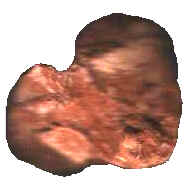|
ACTINOLITE
|
 |
It is a silicate of calcium, magnesium and iron and is fairly hard (5-6 on the mohs scale) and heavy. It is a variety of nephrite but has a different internal structure.
It is an amphibole (a rock which contains a constituent of hydrogen and oxygen) and is usually green-black in colour.
It can be found in igneous or metamorphic rocks and also in dolomites and magnesium rocks. It forms in layers and twinning is often evident. It has perfect cleavage and is pleochroic (shows different colours depending on the angle from which it is viewed).
It may be found close to nephrite and in locations such as Canada, Italy, New Zealand and Siberia.

|
ALABASTER
|
 |
Also known as calcium sulphate it is a variety of gypsum. It is a member of the sulphate group and is very soft (2 on the mohs scale). The best specimens have bands across the surface.
It is normally white. It's name is derived from the word albus which is latin for white. It has a glassy/silky sheen and is used for statues and ornaments.
It forms by evaporation in cavities often in sedimentary rocks and around hot springs. It forms in masses which are very resistant and is fine grained. It is very widespread and can be found in Tuscany, Italy and California, Russia and Mexico.
